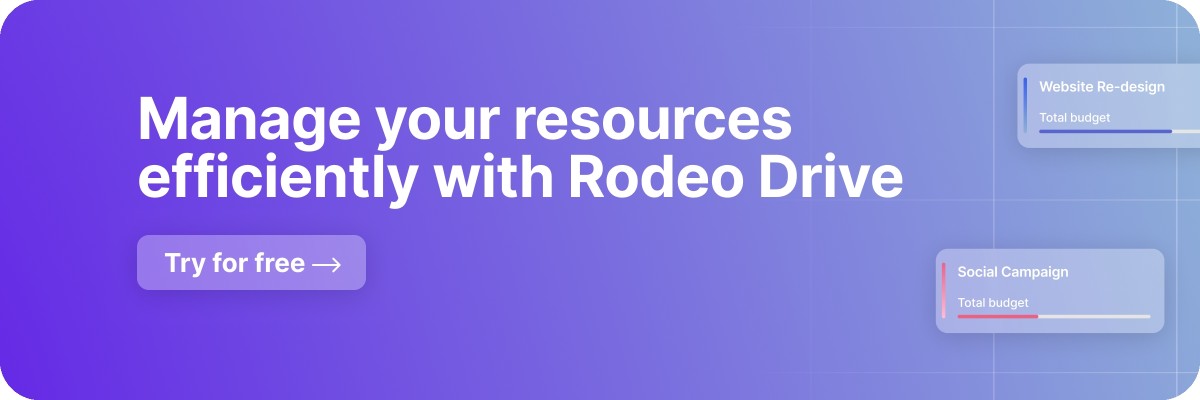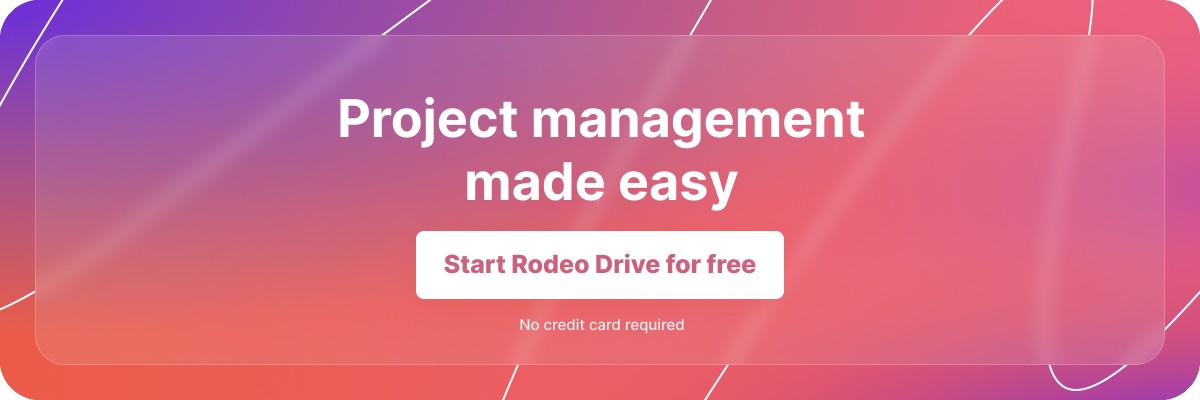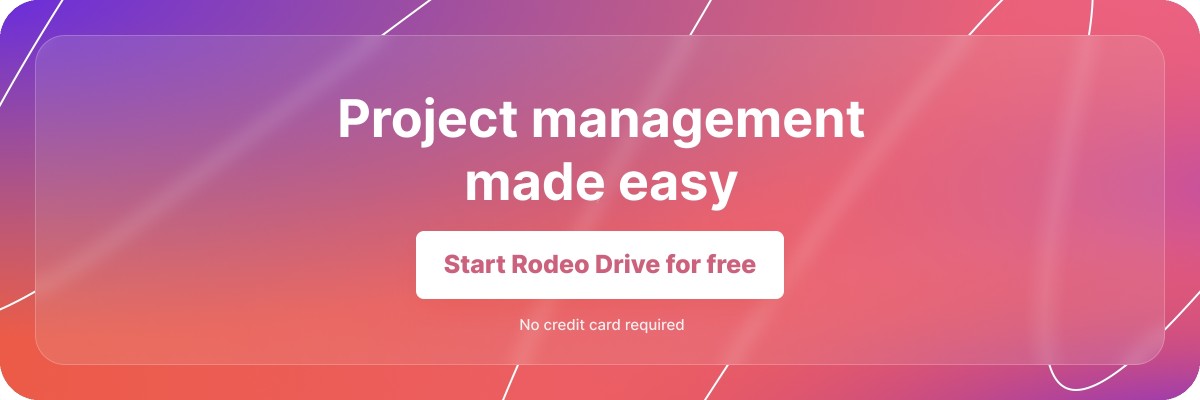16 Workflow Management Software to Ensure Team Success
When you’re caught between shifting tasks and deadlines, it’s hard to prioritize managing your workflow itself. Workflow management software can certainly eliminate confusion and boost the speed at which your team can execute what’s important.
However, the process of auditing your needs, finding the right software, and onboarding a new tool can be a time-consuming project in itself.
In this article, we’ll clear up some of the confusion about workflow management, and share some tips for finding the right solution for your business. Then, we’ll get into 16 great workflow management solutions that you can begin your search with.
What is workflow management?
Workflows are a set of repeatable steps needed to complete a project. In simple terms, workflow management is about optimizing the set of actions required to reach specific goals.
It starts with identifying each step in a work process from start to finish, determining the sequence those steps should be worked on, assigning responsibilities, and using tools to speed up the completion of those steps.
Workflow management has several aims. The first is to help teams move faster on their tasks while still delivering quality. The second is to identify repetitive processes to create opportunities for streamlining and automation.
Chances are, even if the final product of a team’s work varies, the structure of how they do the work remains largely the same.
For example, in a content creation workflow, the typical steps will include coming up with an idea, drafting, editing, approval, and publication. Each step is dependent on the previous one, and every time you need to produce a new piece of content, you’ll cycle through the same workflow.
Therefore, finding ways to optimize each step can help you deliver the same quality of work in less time.
Why do teams find workflow management software useful?
The simple answer is that a workflow management solution streamlines your work. It makes it easier for teams to communicate what everyone is working on; it centralizes information, making it easier to spot inefficiencies; it automates routine tasks, helping teams stay nimbler, and allowing them to allocate more time to activities that benefit from deeper attention.
Here are three additional advantages of employing workflow management software:
Leads to more productive teams
Workflow management software can automate repetitive tasks and reduce manual intervention. This speeds up processes and leads to fewer errors, benefitting a team’s productivity.
Makes collaboration and passing off tasks easier
Workflow management software comes with features that facilitate better communication. Be it shared workspaces, real-time updates, or integrated messaging, these platforms make it easier for teams to stay connected and work together, regardless of their physical location.
Offers enhanced transparency
These tools allow managers to track progress and identify bottlenecks in real time. This helps keep everyone accountable for their tasks and ensures that everything tracks with the project’s deadlines.
How to choose workflow management software
When choosing workflow management tools, you should take the following steps:
1. Identify your needs: Figure out the specific challenges your team runs into repeatedly. Also consider factors such as the size of your team, the complexity of your projects, and a shortlist of must-have features.
2. Evaluate features: Look for software that offers the essential features for your workflow. Do you need task automation? Help with collaboration? Customization options or integrations with your other tools? Different options have more or less capability in each of these areas, so looking around is the key to finding the best fit.
3. Consider usability: Many platforms have a learning curve. It’s worth thinking about whether you want something intuitive but less robust, or whether you need the benefits of something more complex, even if requires more time to onboard your team. Adopting new software is time-intensive, so it’s worth also looking into how much support from customer success each solution offers since it can take a lot of onboarding work off your plate.
4. Check for scalability: Make sure the software can grow with your team. Can it accommodate more users, projects, and complex workflows as your organization expands?
5. Read reviews and request demos: Look at reviews from sites like Capterra and G2 to gauge the experiences of other users with the software. Additionally, most companies offer free trials or demos, so take advantage of those to test the software’s suitability for your needs.
By following these steps, you can find a tool that meets your current needs but also supports your team’s success in the long run.
Top 16 workflow management software tools to consider implementing
Now that you have an overview of workflow management, let’s get you on your way to finding the right software for your business processes. Here are 16 of the best workflow management tools that you should consider.
1. Rodeo Drive
Rodeo Drive is a project management tool that features planning, budgeting, time-tracking, and reporting features that help teams build smoother workflows.
Rodeo Drive is best suited for teams that need financial management integrated into their project workflows. All the features on the platform — from activity planning to time-tracking — are connected to your project budget, which updates in real-time as your team works.
Who is Rodeo Drive for?
Although Rodeo Drive was built with the needs of creative agencies in mind, it has the flexibility to be used by any project-based team. Organizations that charge for projects based on billable hours, deal with purchase orders, or run multiple projects in parallel will find features in Rodeo Drive that simplify those workflows.
Here’s a closer look at some of Rodeo Drive’s key features:
Phased budgeting and QuickBooks integration
Rodeo Drive allows you to organize your budget by project phase. This makes it so that if you’re dealing with a project that has multiple stages, you can budget the expenses and activities for each stage, providing a more accurate and sound financial plan.
Within your phased budget you can also add markups to your expenses, allowing you to plan your profitability before the project even kicks off.
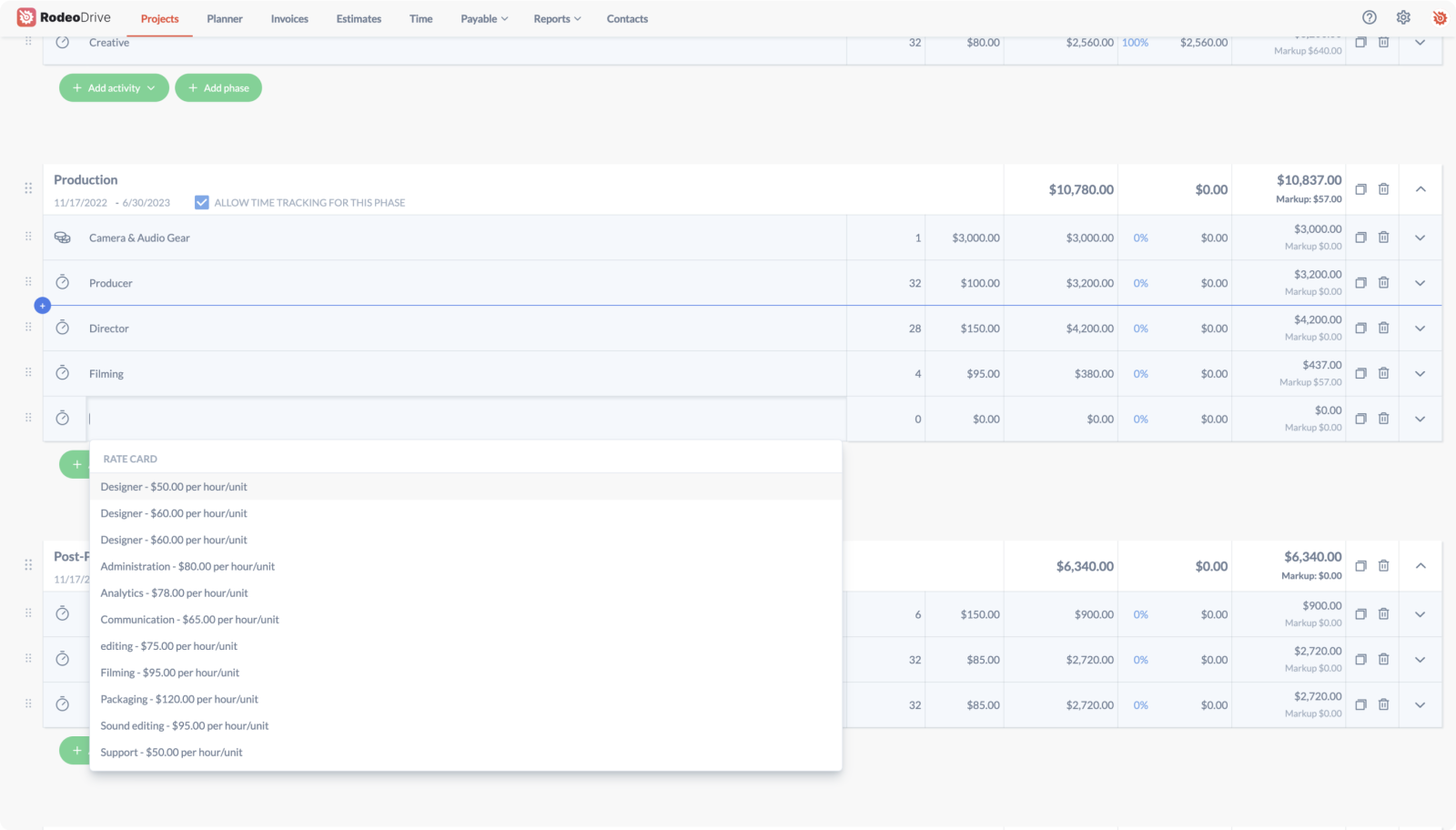
Account for all project activities and expenses in Rodeo Drive’s budget
Additionally, if your organization uses QuickBooks for accounting, Rodeo Drive’s Quickbooks integration lets you send invoices created in Rodeo Drive directly into Quickbooks, keeping your project financials in line with your bookkeeping.
You’ll never have to re-enter data from one platform into the other, creating a transparent financial workflow between your project management team and accounting team.

Your budget metrics update in real-time as your team tracks time
Reporting for at-a-glance insights into team progress
Rodeo Drive generates a Time report for a quick overview of your team’s billable hours. You can analyze how your team spends its time by activity, client, or project, and oversee the cost of every activity.
You can use this data to gauge where time is being spent across all your projects and find opportunities to optimize your team’s time usage based on priorities. It’s especially helpful for identifying potential blockers in your team’s workflow.
.png)
Rodeo Drive’s Time report highlights how each team member is spending their time
Using Rodeo Drive’s Productivity report, you can understand how many available hours each of your team members have scheduled and how many they’ve tracked toward projects. Project managers can use this data to find and allocate unused capacity.
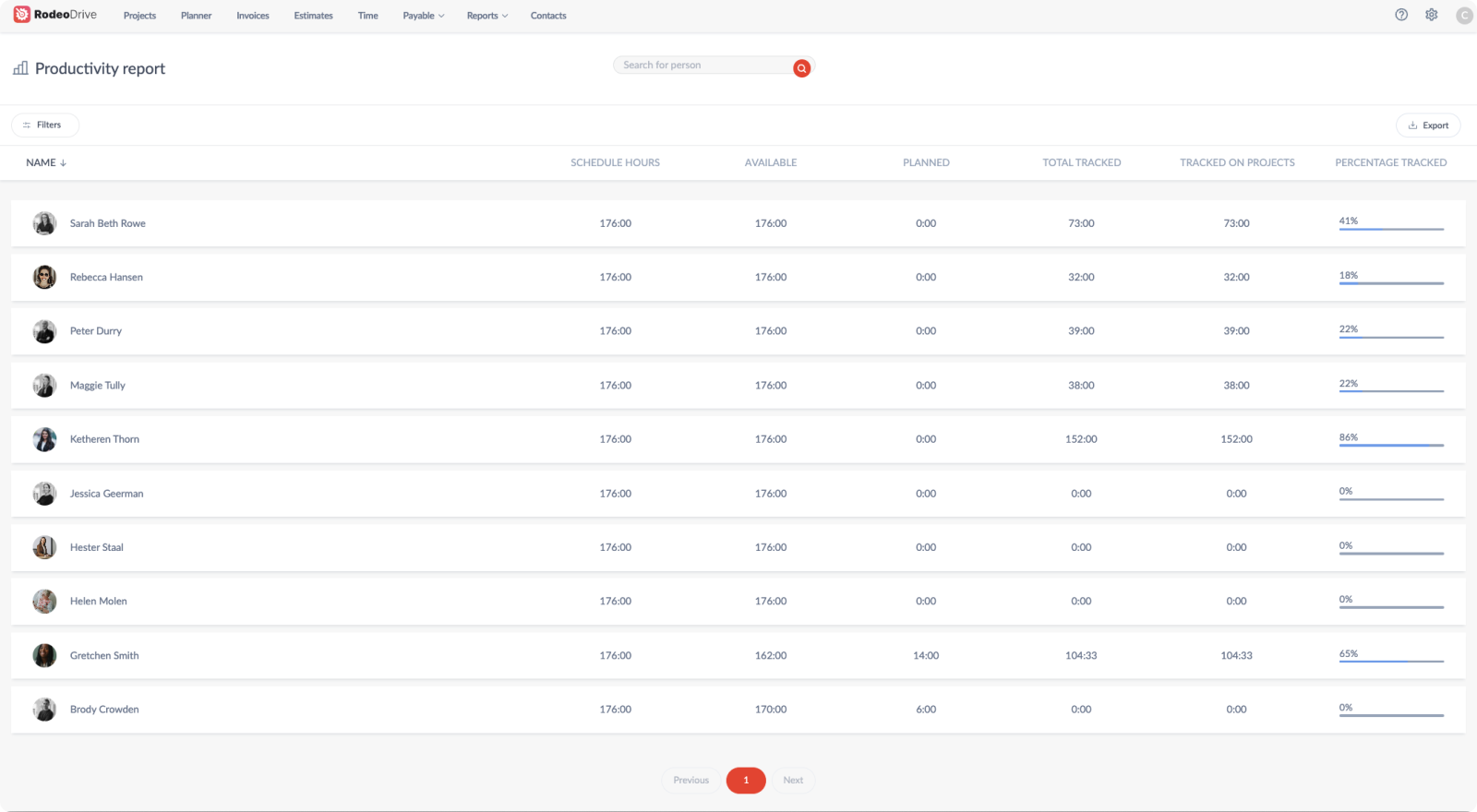
Understand your resource utilization at a glance with the Productivity report
Timeline-view planner for activity planning
As for your team’s workflow itself, Rodeo Drive lets you schedule and visualize project activities from an intuitive timeline view. This allows you to see activities across all your projects at once, or filter down to an individual project for a more granular view of who’s working on what.
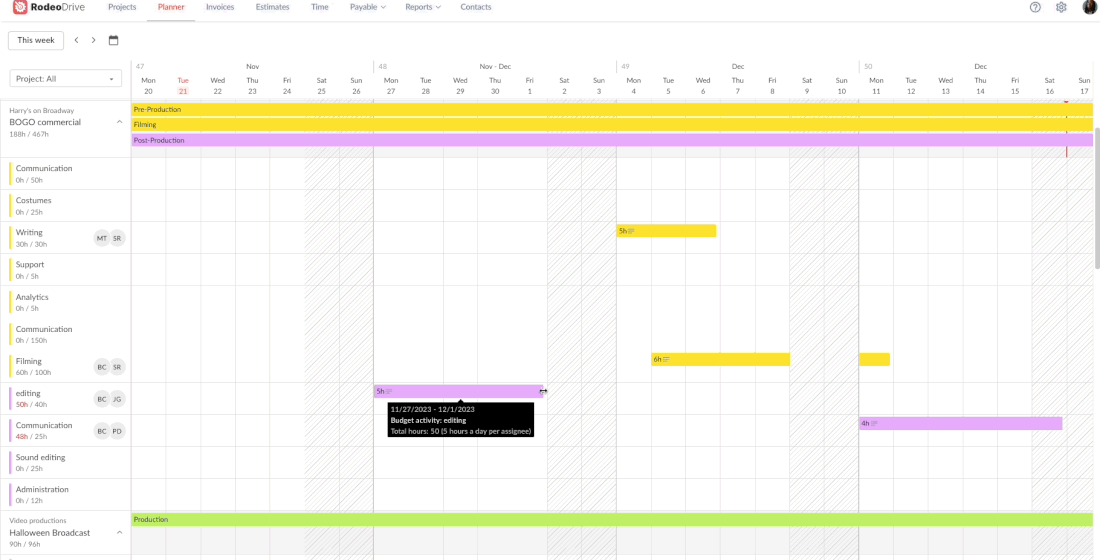
Assign and oversee project activities in Rodeo Drive
And should your project activities change, you can easily reschedule tasks in Rodeo Drive’s planner using the drag-and-drop functionality.
Rodeo Drive’s additional features
- Automatically generate and send estimates based on your proposed budget.
- A people view within your planner to see capacity and resource utilization at a glance.
- Contact management to keep your vendor and client information centralized to make purchase orders and invoicing easier.
Rodeo Drive’s weaknesses
- No agile visualizations like Gantt charts or Kanban boards.
- Rodeo Drive doesn’t currently offer a mobile app, although it's on the roadmap for future development.
Rodeo Drive’s pricing
Rodeo offers flexible pricing with two plans, the free plan and the achiever plan. Here’s what each includes:
- Free plan: 3 active projects, project budgets, QuickBooks integration, and more
- Achiever plan ($14.99 per user/month): Unlimited projects, in-depth reporting, free guest users, live chat support, and more
And unlike most free plans, Rodeo Drive’s offers QuickBooks integration. Try Rodeo Drive for free today and as a bonus, get complimentary access to the Achiever plan during your trial.
2. ProofHub
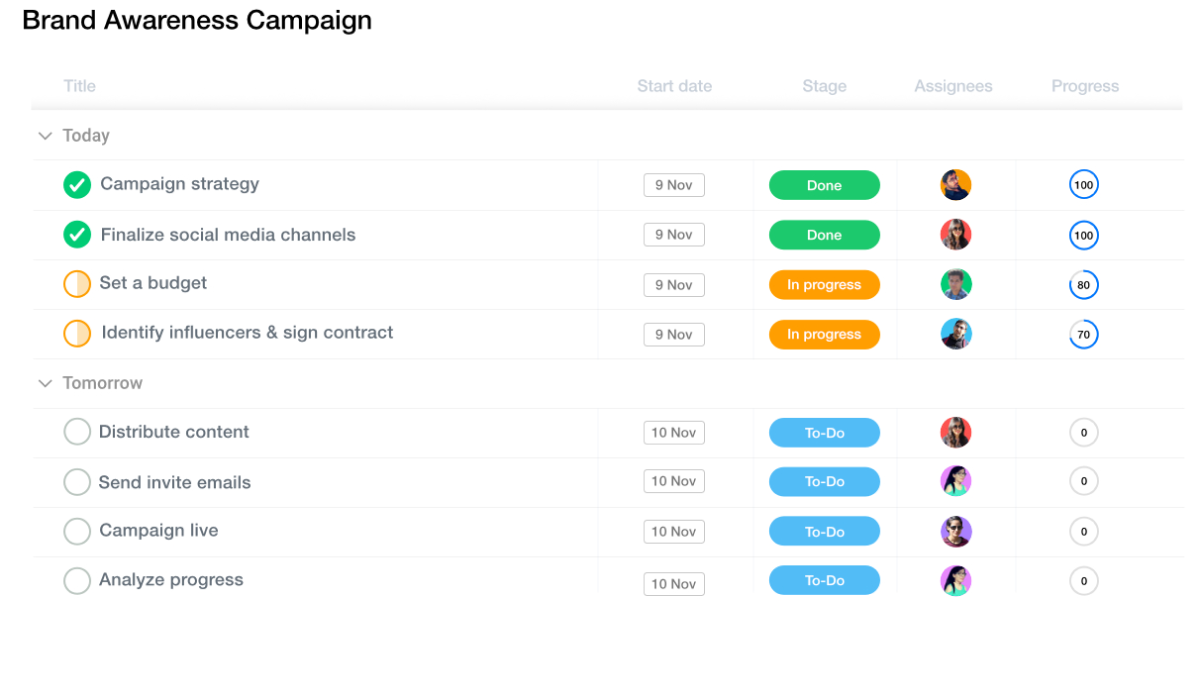
Source: ProofHub
ProofHub serves as a singular workflow management platform for planning tasks, sharing files, communicating with team members, and tracking project progress.
It facilitates a resource-based approach to managing teams, focusing on views for resource allocation, tracking ongoing operations, and matching employee skills with outstanding tasks.
ProofHub’s popular features
- Premade project templates for building new projects
- Time-tracking for agencies and businesses that rely on timesheets
- Strong milestone and goal-tracking features
- In-platform tools for document proofing
ProofHub’s weaknesses
- Lack of automation
- Limited invoicing and budget management features
ProofHub’s pricing
- Essential plan ($50 per month)
- Ultimate plan ($99 per month)
3. Hive
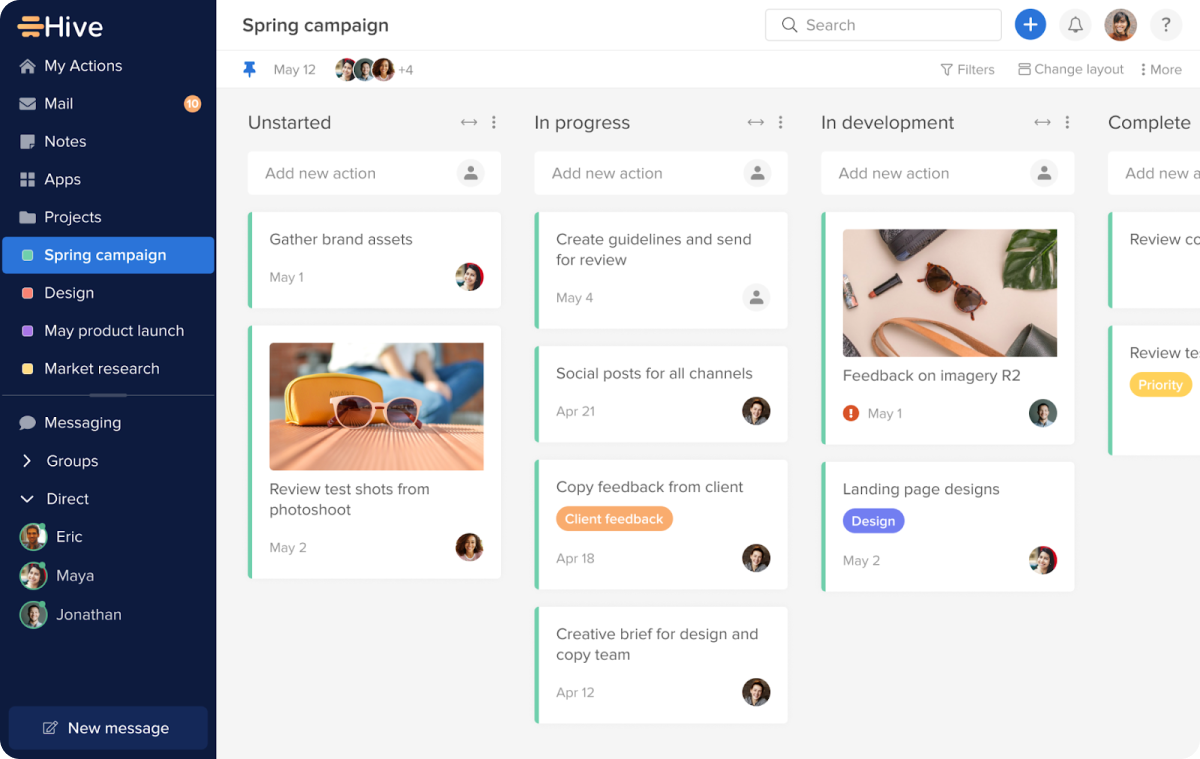
Source: Hive
Hive is a dynamic project management platform designed to cater to various types of teams and workflows. It simplifies the organization of multiple projects and helps order tasks based on priority.
The tool also offers clear views of project workflows and supports agile methodologies with Kanban and Gantt views. Hive also has integrations with video conferencing tools like Zoom and Google Meet.
Hive’s popular features
- Individual users can customize layouts based on personal preferences
- Can track team assignments over multiple projects
- Plenty of integrations
Hive’s weaknesses
- Lack of detailed reporting
- Navigation involves a learning curve
- Platform prone to lagging
Hive’s pricing
- Solo plan (Free)
- Teams plan ($18 per user/month)
- Enterprise plan (Pricing upon request)
Also read: Hive Alternatives: A Complete Comparison of Competing Software
4. Monday
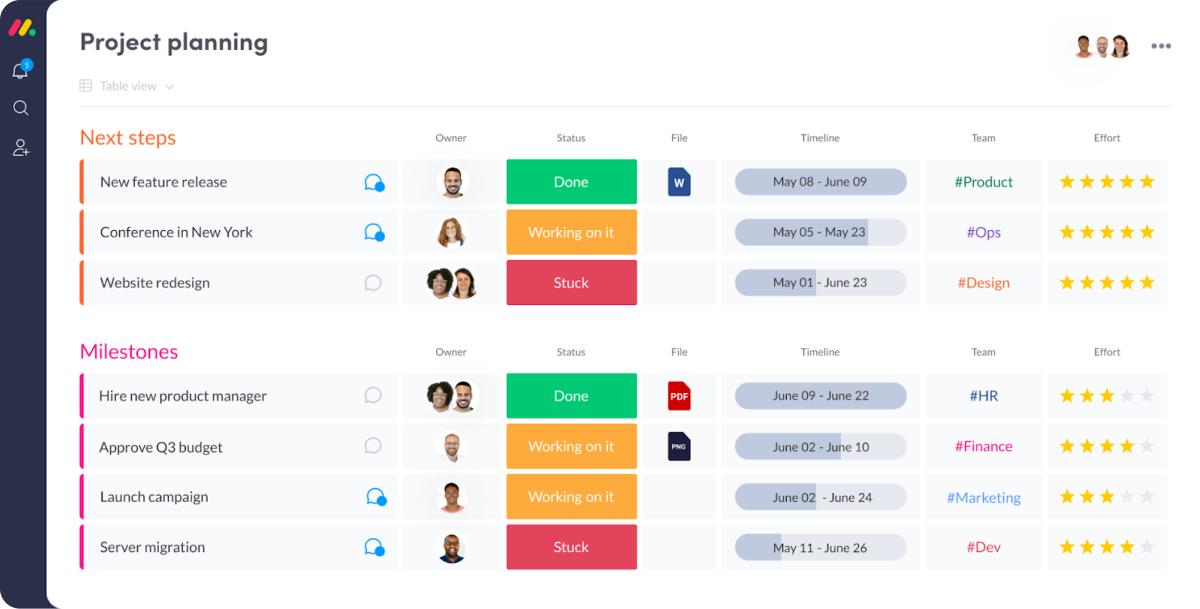
Source: Monday
Monday is a versatile work management system that caters to teams that need heavy customization. It has a user-friendly interface and offers familiar social media-type interactions — with mentions, likes, and gifs — which make it engaging for team communication.
Monday is adaptable to a wide range of workflows. It supports marketing and customer relationship management, sales, agile software development, HR, and IT management. The platform’s onboarding personalizes the experience based on user needs, and there are plenty of online resources to help navigate the platform.
Monday’s popular features
- Custom automated workflows to eliminate repetitive tasks
- Integration with over 1,000 external tools
- Various project views for flexible visualization
Monday’s weaknesses
- Customizing the platform has a steep learning curve
- Pricing can be expensive depending on feature requirements
Monday’s pricing
- Individual plan (Free)
- Basic plan ($10 per user/month)
- Standard plan ($12 per user/month)
- Pro plan ($20 per user/month)
- Enterprise plan (Pricing upon request)
Also read: Top 25 Monday Alternatives to Try
5. Asana
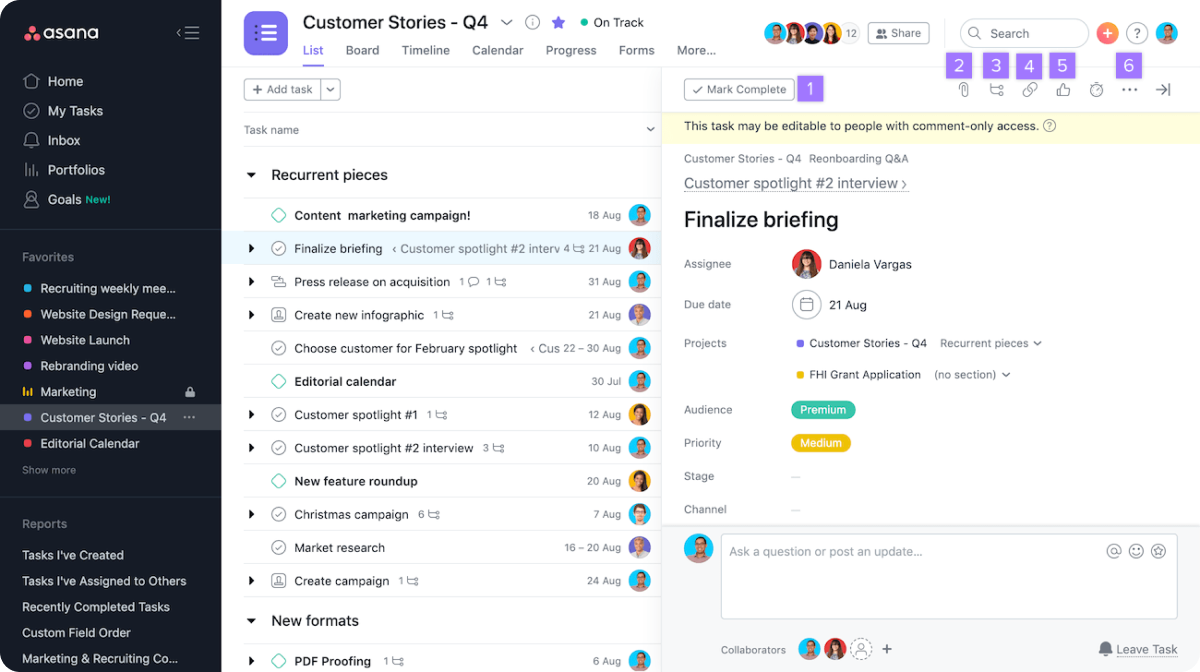
Source: Asana
Asana is designed mainly with collaboration and project task tracking in mind. It can be used for deadline management and to divide complicated workflows into smaller, actionable tasks. Asana has many project use cases ranging from marketing campaigns, design projects, product roadmaps, sales pipelines, and more.
It’s a great choice if your team needs to quickly build structure into its workflow management without committing months to learning a new platform.
Asana’s popular features
- High visibility on workloads across projects
- Task management, including subtasks and tags
- Custom coding-free workflows
- Over 200 integrations
Asana’s weaknesses
- Limited customization options
- Doesn’t have robust financial management for project teams that require it
- Not the strongest fit for teams requiring automated workflows
Asana’s pricing
- Basic plan (Free)
- Premium plan ($13.49 per user/month)
- Business plan ($30.49 per user/month)
- Enterprise plan (Contact sales)
6. Scoro
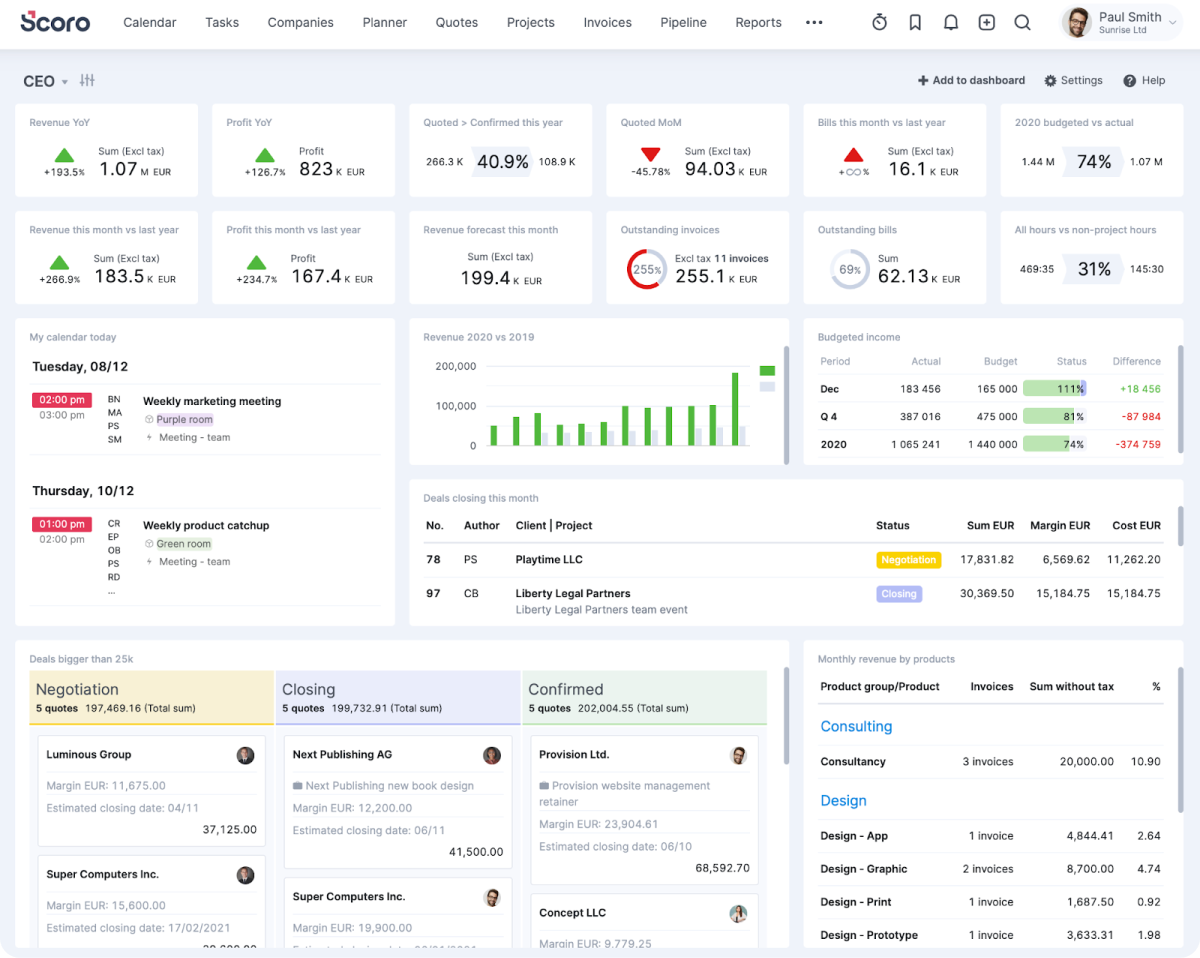
Source: Scoro
Scoro is a work management solution catered to consultancies, agencies, and professional services. Scoro incorporates project management, financial management, and analytics into one ecosystem. One of its more advanced features is resource forecasting, which allows project managers to anticipate when additional human resources like freelancers will be needed.
Scoro’s popular features
- A hub to view all your projects
- Quoting, invoicing, and tracking financial reports
- Customizable dashboards
Scoro’s weaknesses
- Limited integration with email platforms and lack of contact management
- Pro plan necessary for integrations like QuickBooks
- Extremely costly compared to other competitors
Scoro’s pricing
- Essential plan ($28 per user/month)
- Standard plan ($42 per user/month)
- Pro plan ($71 per user/month)
- Ultimate plan (Contact for pricing)
- Note: All plans require a minimum of 5 users and onboarding assistance is an additional cost.
7. Wrike
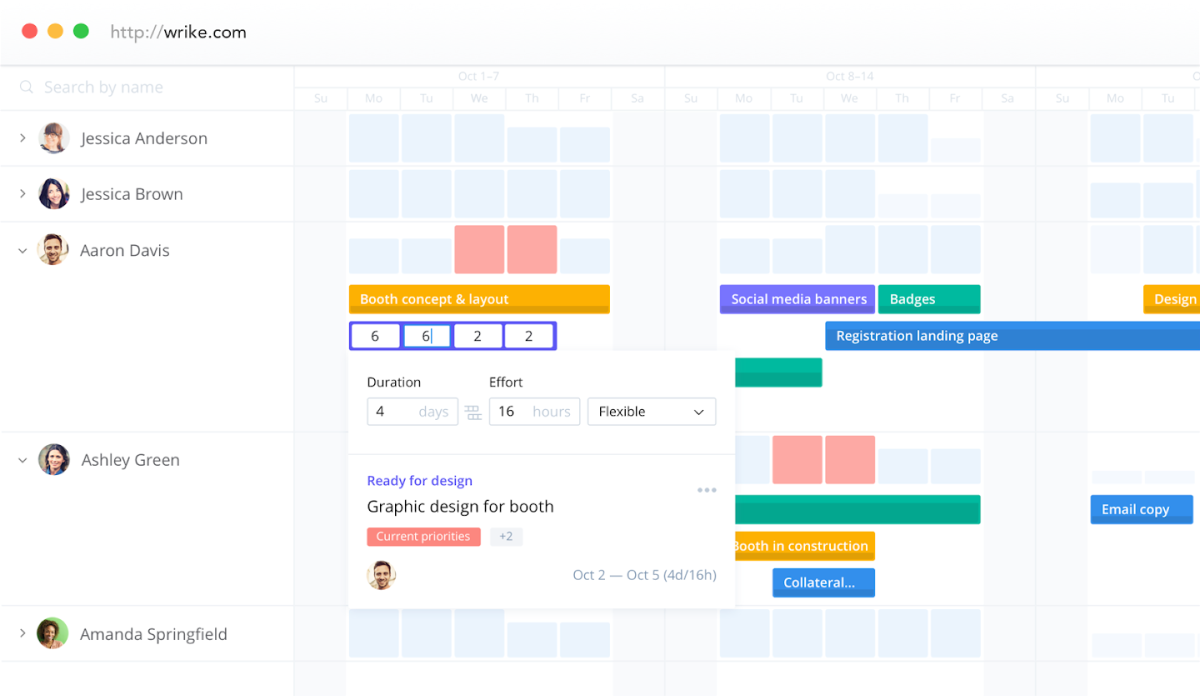
Source: Wrike
Wrike is a comprehensive work and project management software suitable for various types of teams, workflows, businesses, and industries.
As a cloud-based platform, it offers centralized management for projects, enhancing organization, visibility, and collaboration across both internal and external stakeholders. The platform is flexible and scaleable, making it a good option for organizations that have a niche use case and need something customizable.
Wrike’s popular features
- Good for specialized use cases like event planning, product roadmaps, custom request forms, and work schedule management
- Shared team calendars for project visibility and customizable workflows for productivity
- Strong customer support and community knowledge base
Wrike’s weaknesses
- Security features are limited to the enterprise plan
- Given Wrike’s minimum user requirements, costs are high relative to many similar tools on the market
Wrike’s pricing
- Free plan
- Team plan ($9.80 per user/month)
- Business plan ($24.80 per user/month)
- Enterprise plan (Contact sales)
- Pinnacle plan (Contact sales)
Also read: Wrike Alternatives: Comparing Top Competitors
8. Basecamp
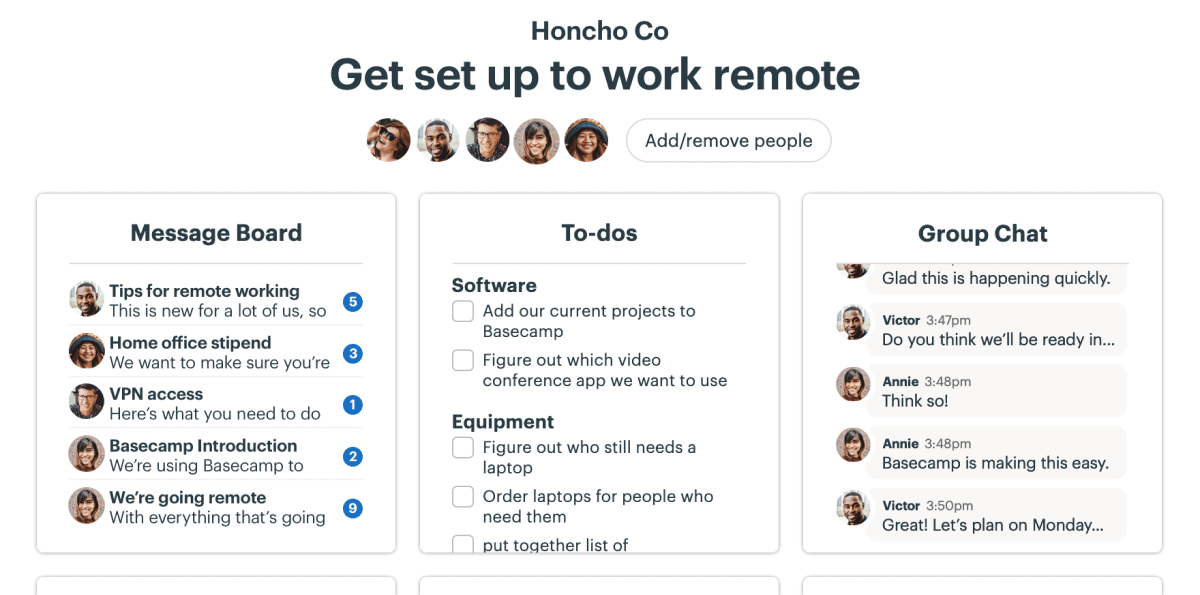
Source: Basecamp
Basecamp has a straightforward design, making it an attractive choice for teams looking for an easy-to-use solution. It is aimed at teams that need more collaborative workflows, with features that focus on organizing projects and keeping operations visible.
Basecamp’s popular features
- Message boards and chat features
- Automated check-in questions
- Cloud-based file storage in the platform
Basecamp’s weaknesses
- Ease of use is at the expense of limited customization
- Reporting capabilities are relatively basic with no in-depth analytics
- No built-in time tracking for teams that require it
Basecamp’s pricing
- Individual plan ($15 per user/month)
- Pro Unlimited plan ($349 per month for unlimited users)
9. Kissflow
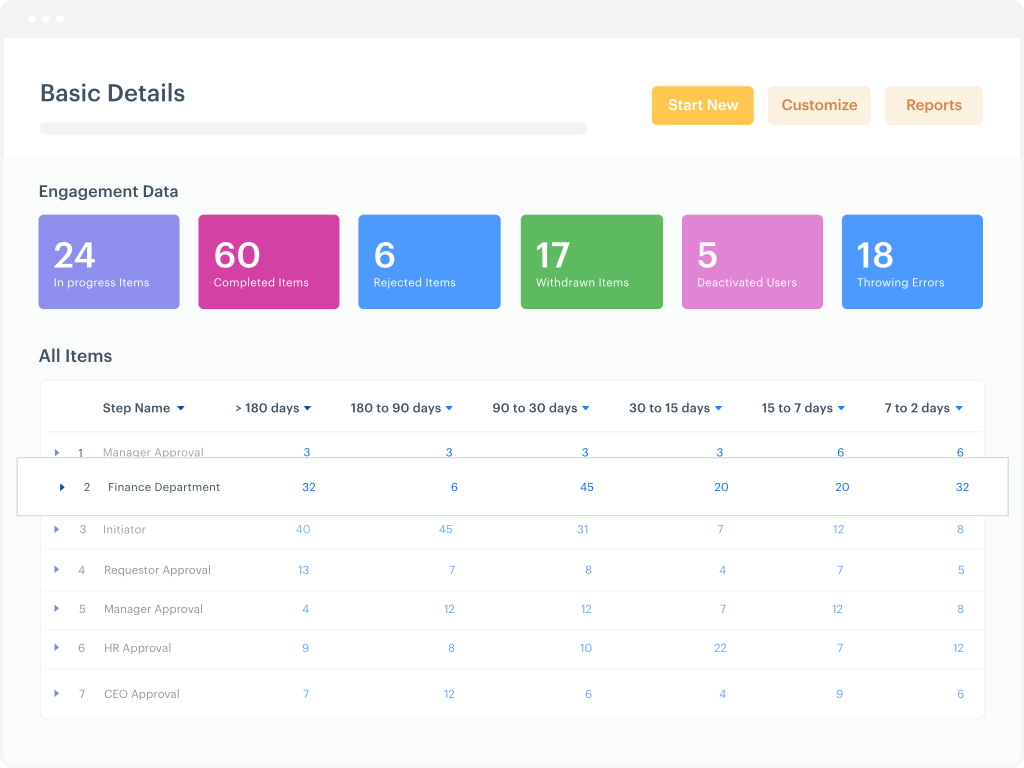
Source: Kissflow
Kissflow is a highly adaptable enterprise workflow management software built to scale with the needs of larger organizations. The platform is especially useful for creating approval processes, employee onboarding, and tracking complex, cross-functional tasks.
Kissflow’s popular features
- Customization is robust enough to tailor workflows to specific project needs
- Broad range of available integrations
- Comprehensive reporting and analytics features
Kissflow’s weaknesses
- Setting up integrations can be challenging
- Pricing is prohibitive for businesses that aren’t enterprise-sized
- Limited mobile experience
Kissflow’s pricing
- Basic plan (Starts at $1,500 per month)
- Enterprise pricing (Contact sales)
10. Teamwork
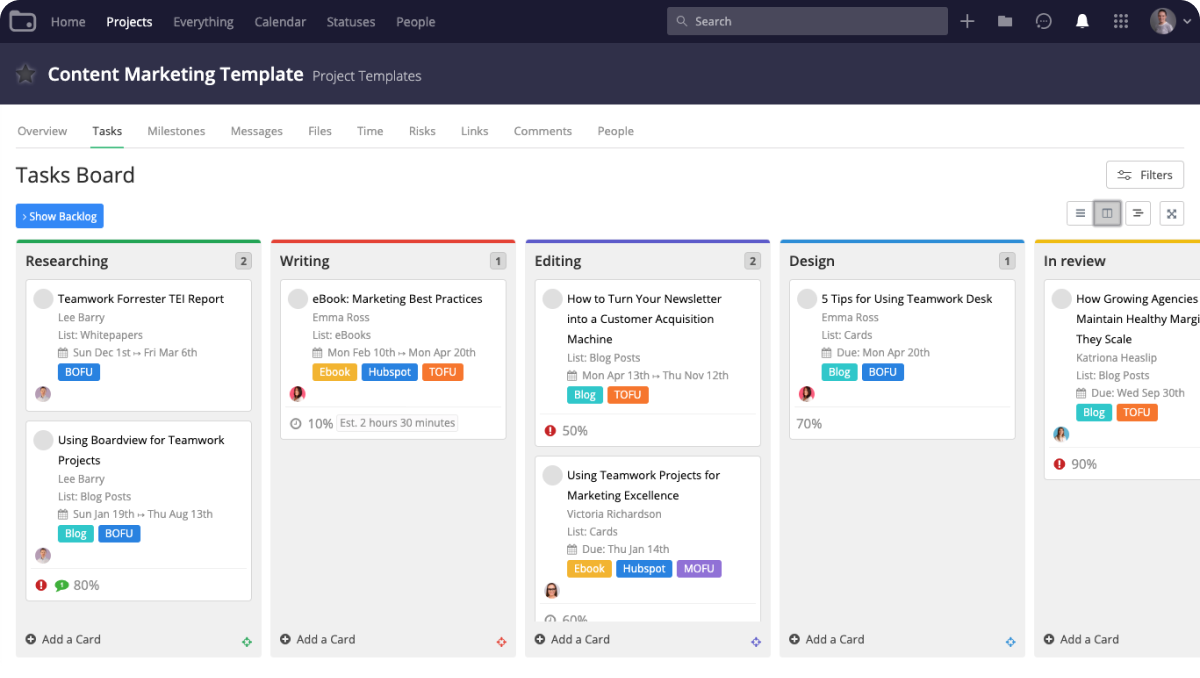
Source: Teamwork
Teamwork emphasizes visual project management, allowing managers to prevent bottlenecks and prioritize tasks efficiently across multiple projects. Teamwork is especially popular among agencies and medium-sized businesses due to its free client users feature and robust capacity management capabilities.
Teamwork’s popular features
- Strong task management features
- Client management features for agencies
- In-app document proofing
Teamwork’s weaknesses
- User interface can be unintuitive for some
- Platform has a learning curve for those new to project management software
Teamwork’s pricing
- Free plan
- Starter plan ($8.99 per user/month, 3 user minimum)
- Deliver plan ($13.99 per user/month, 3 user minimum)
- Grow plan ($25.99 per user/month, 5 user minimum)
- Scale plan (Contact sales)
11. Rocketlane
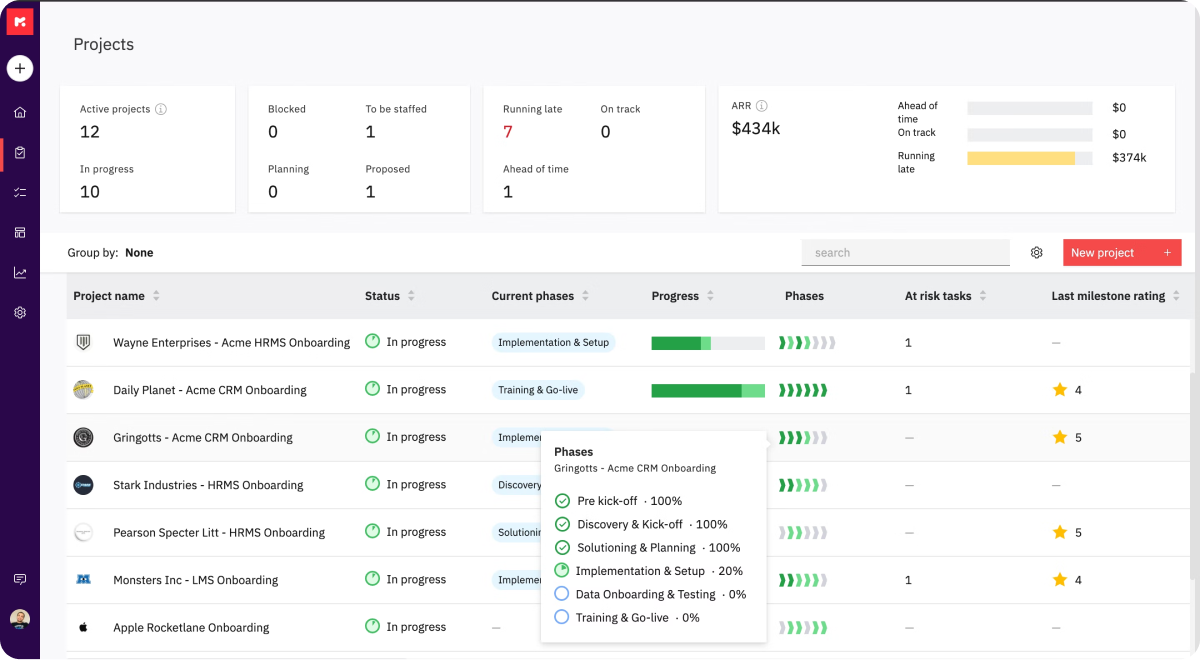
Source: Rocketlane
Rocketlane is designed to optimize customer onboarding and professional services automation.
It stands out for its ability to streamline project management, resources, and financials in a unified workspace, enhancing visibility, collaboration, and consistency across teams. It’s a client-centric tool that integrates easily with various tech stacks.
Rocketlane’s popular features
- Integration with CRMs like Hubspot
- User-friendly task management
- Strong customer support and onboarding
Rocketlane’s weaknesses
- No free plan available
- Onboarding is time-consuming because of the extensive customization
- Limited reporting functionality
Rocketlane’s pricing
- Essential plan ($29 per user/month)
- Standard plan ($59 per user/month)
- Premium plan ($79 per user/month)
- Enterprise plan ($99 per user/month)
- Note: All plans require a minimum of 5 users.
12. Airtable
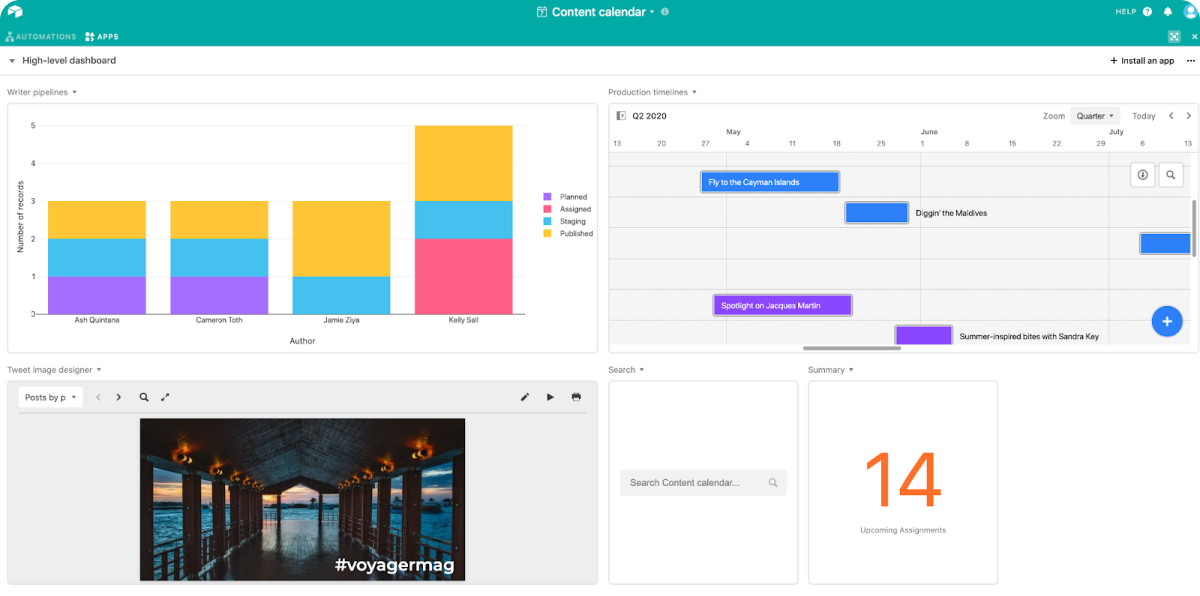
Source: Airtable
Airtable combines the functionality of a spreadsheet with the power of a database, offering a versatile platform for project management and workflow automation. It's designed to cater to a wide array of business sizes and types, providing a flexible solution for managing data, projects, and collaborative work.
Airtable’s popular features
- Can build custom workflows for marketing, product, finance, and HR use cases
- Generative AI integrated into the platform
- Integration with Tableu, Jira, Salesforce, Zendesk, and Google Drive
Airtable’s weaknesses
- User interface is difficult to navigate
- Difficult to keep information organized in the platform
- Dashboard is intuitive, but relatively limited in terms of customization
Airtable’s pricing
- Free plan
- Team plan ($24 per user/month)
- Business plan ($54 per user/month)
- Enterprise scale plan (Contact sales)
13. ClickUp
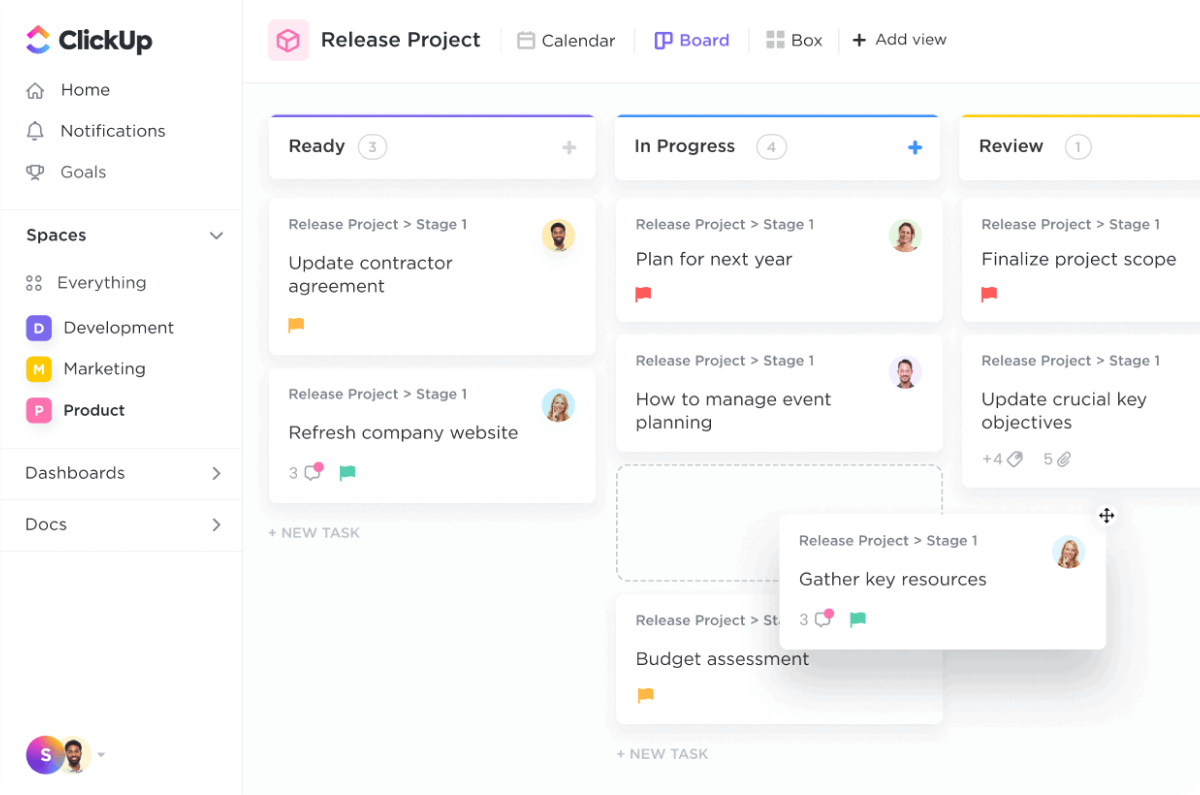
Source: Clickup
ClickUp positions itself as a highly versatile project management software, catering to a broad spectrum of users from solopreneurs to large enterprise teams.
Its all-encompassing platform is designed to centralize tasks, documentation, communication, and goal setting into one intuitive system, streamlining workflow processes across different departments such as project management offices, operations, marketing, and more.
ClickUp’s popular features
- To-do lists sorted based on task priority
- Advanced workflow automations
- Useful for cross-functional teams since it integrates with other project management tools like Wrike and Asana
ClickUp’s weaknesses
- User interface has many collapsible menus that can hide features
- Mobile app experience is less feature-rich than the desktop
ClickUp’s pricing
- Free plan
- Unlimited plan ($10 per user/month)
- Business plan ($19 per user/month)
- Enterprise plan (Contact sales)
Also read: Top 20 ClickUp Alternatives to Try
14. nTask
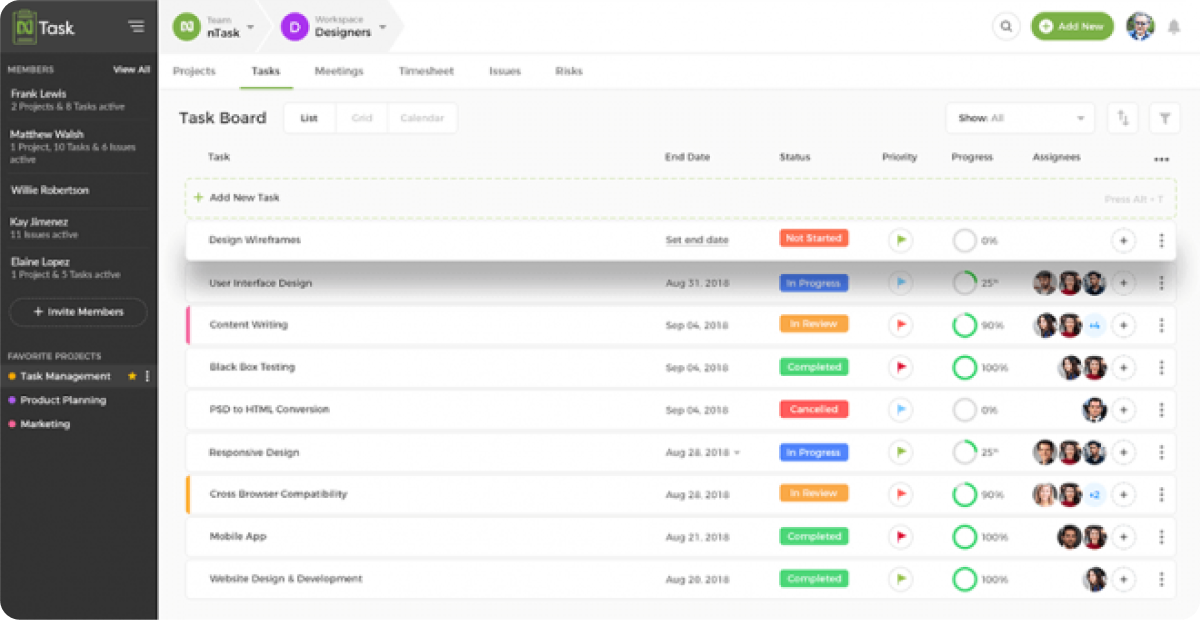
Source: nTask
nTask is an all-in-one project management software that provides a comprehensive suite of tools for task management, Gantt charts, meeting management, team collaboration, issue tracking, Kanban boards, time tracking and timesheets, and risk management.
It is designed to cater to a wide range of business needs, allowing teams to manage projects, communications, and reporting from a single platform. nTask aims to boost productivity and efficiency by offering end-to-end project management capabilities, including in-depth planning, crystal-clear updates, focused task management, and effective time tracking.
nTask’s popular features
- Project risk management features
- Features to manage meetings
- Wide variety of views including task lists, a calendar, Gantt charts
- Inexpensive pricing
nTask’s weaknesses
- Limited customization for dashboard layouts
- Free version is very limited
nTask’s pricing
- Free plan
- Premium plan ($4 per user/month)
- Business plan ($12 per user/month)
- Enterprise plan (Contact sales)
15. Nifty
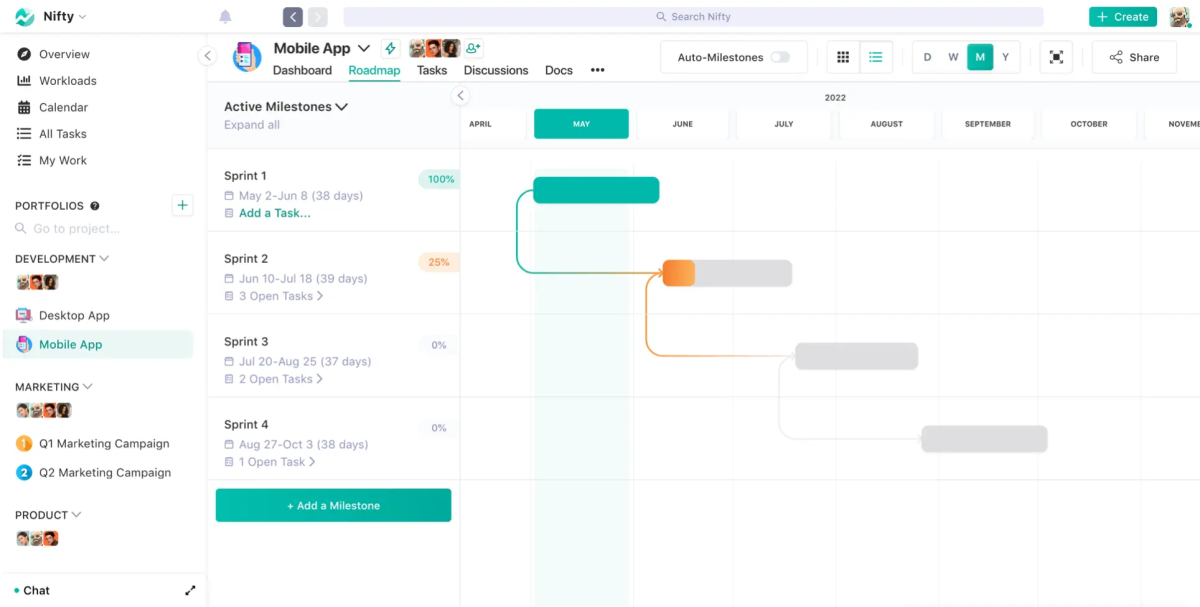
Source: Nifty
Nifty is a project management software that offers a robust free plan, real-time collaboration tools, and competitive paid plans.
Nifty's features cater to various aspects of project management, including task and workflow management, collaboration, and reporting, though it does have limitations in terms of native integrations and support options.
Nifty’s popular features
- Easy to manage a large portfolio of projects
- Plenty of task management views
- Useful for teams that need an all-in-one solution since it includes chat functionality along with document and file storage
Nifty’s weaknesses
- Load times are sometimes slow
- Limited resource allocation and cost-tracking features
- Unable to create invoices from within the platform
Nifty’s pricing
- Free plan
- Starter plan ($9 per user/month)
- Pro plan ($16 per user/month)
- Business plan ($25 per user/month)
- Enterprise plan (Contact sales)
16. Trello

Source: Trello
Trello is a versatile project management tool that operates on a board and card system, facilitating collaboration and organization across various types of projects.
It is well-suited for agile methodologies, offering features like Kanban boards, Gantt charts, and real-time collaboration tools. However, managing complex multi-stage projects and larger teams may require additional tools or add-ons to extend Trello's capabilities.
Despite this, Trello's simplicity and adaptability make it a useful tool for a variety of contexts.
Trello’s popular features
- Workflow automation
- Templates to easily create new tasks
- Kanban and agile task management support
Trello’s weaknesses
- While suited for simpler workflows, the list-based nature of the platform doesn’t scale with more complex projects
- Lack of real-time reporting and analytics for deeper project understanding
Trello’s pricing
- Free plan
- Standard plan ($6 per user/month)
- Premium plan ($12.50 per user/month)
- Enterprise plan ($17.50 per user/month)
Takeaway
There you have it — 16 of the best workflow management tools on the market. Each offers a unique set of features that can enhance your team’s productivity and streamline your operations.
Of course, with so many options available, selecting the right tool starts with a careful examination of your specific needs.
For example, if you need a light task management solution, then Trello might be a good answer. Its simple Kanban structure makes it perfect for freelancers working alone or small teams looking for simplicity.
On the other hand, if your requirements extend beyond basic task management, then looking at solutions with more robust project management functionality makes more sense. Workflows requiring a balance of task and project management functionalities might benefit from Scoro, for instance.
Every tool will have its relative strengths and focus areas. After finishing your research, take advantage of free trials to get a better feel of the solutions on your shortlist. Many of the tools on this list offer them, so try to get firsthand experience of how the software fits with your operations before committing.
For teams that regularly handle financial tasks — such as sending invoices, managing budgets, or tracking billable hours — Rodeo Drive is a strong solution. It’s designed with project-based teams in mind, with features that help both in managing project activities and finances.
Start using it for free today, no credit card required.





